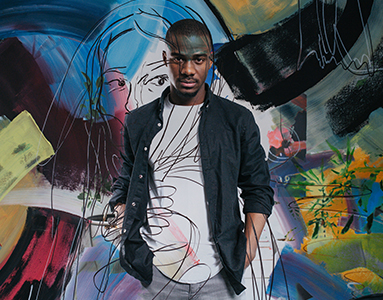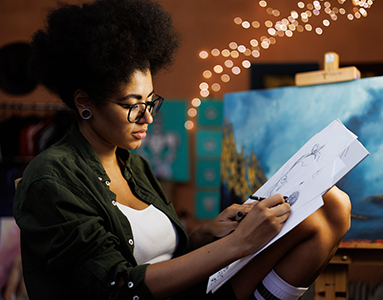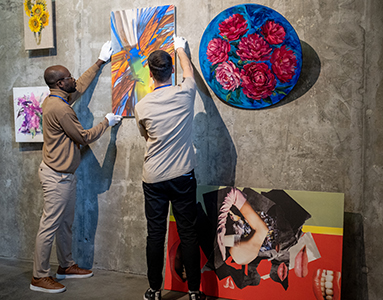Contemporary Arts Practices, B.S.
About This Program
Students of both the Contemporary Arts Practices track — and the Game Art track — can expect:
Personalized Learning Experience:
Our intimate program ensures that you’re known by name, receiving tailored instruction
that nurtures your unique artistic vision and personal growth.
Hands-On Opportunities:
Engage in dynamic, real-world projects throughout your journey at FAMU, including
the chance to curate your own exhibitions at the Foster-Tanner Fine Arts Gallery.
These opportunities allow you to experiment, refine your skills, and prepare for a
career in the contemporary and digital art world.
Successful Alumni Network:
Our graduates have made significant strides in the art world and beyond, gaining acceptance
into top graduate programs and thriving in creative industries. Join a community of
successful alumni who are shaping the future of contemporary and digital art.
Both Contemporary Arts Practice and Game Art emphasize creativity, innovation, and a deep understanding of cultural contexts, preparing individuals to contribute significantly to contemporary artistic and digital landscapes.

What is Contemporary Art Practices?
This program typically includes:
• Studio Work: Emphasis on hands-on creation, encouraging experimentation with various mediums.
• Critical Theory: Exploration of art theory, philosophy, and criticism to understand the role of art
in society.
• Interdisciplinary Approaches: Integration of different fields, such as performance art, digital media, and installation.
Types of Graduates - Graduates often pursue careers as:
• Visual artists (painters, sculptors, installation artists)
• Curators or gallery managers
• Art educators or facilitators
• Art critics or writers
• Community art organizers

Contemporary Arts Practices Careers
Upon completing a degree in Contemporary Art Practice, individuals often explore diverse
career paths that leverage their creative skills and artistic vision.
Many graduates become visual artists, working in mediums such as painting, sculpture,
or installation art, while others may pursue roles as curators or gallery managers,
organizing exhibitions and managing collections. Art educators also play a vital role,
teaching in schools or community programs.
Additionally, some graduates find opportunities as art critics or writers, contributing
to publications and reviews, or as public art coordinators, facilitating community
art projects. The interdisciplinary nature of the program allows for unique roles
in art therapy, consulting, and community engagement, reflecting the broad impact
of contemporary art.
• Visual Artist: Painter, sculptor, installation artist, or multimedia artist.
• Art Curator: Responsible for organizing exhibitions and managing art collections.
• Gallery Manager: Oversees the operations of art galleries, including exhibitions and sales.
• Art Educator: Teaches art in schools, universities, or community programs.
• Art Critic/Writer: Writes reviews, articles, and essays on contemporary art.
• Community Art Organizer: Facilitates art programs and projects within communities.
• Art Consultant: Advises individuals or organizations on art purchases and collections.
• Public Art Coordinator: Manages public art projects and initiatives.
• Art Therapist: Uses art as a therapeutic tool to support mental health.
• Art Historian: Researches and documents the history and significance of contemporary art movements.

Contemporary Arts Practices Employment Expectations
The States with the highest employment rate for Contemporary Art Practice are:
1. California
Key Cities: Los Angeles, San Francisco, San Diego
Opportunities: Major art institutions, galleries, and festivals; strong freelance
market.
2. New York
Key City: New York City
Opportunities: Home to numerous galleries, museums, and art fairs; high competition
but abundant networking options.
3. Texas
Key Cities: Austin, Houston, Dallas
Opportunities: Growing art scene with a mix of galleries, public art projects, and
festivals.
4. Illinois
Key City: Chicago
Opportunities: Rich cultural institutions and a diverse art community; many exhibitions
and public art initiatives.
5. Florida
Key Cities: Miami, Orlando, Tampa
Opportunities: Vibrant art markets, especially in Miami with Art Basel; increasing
demand for artists in community projects.
6. Washington
Key City: Seattle
Opportunities: Strong support for the arts, numerous galleries, and public art programs
7. Massachusetts
Key City: Boston
Opportunities: Home to prestigious institutions and a thriving art community; educational
opportunities in art theory and practice.
8. Oregon
Key City: Portland
Opportunities: Growing art scene with a focus on community engagement and public art.
9. Pennsylvania
Key City: Philadelphia
Opportunities: Diverse artistic community with numerous galleries and institutions
promoting contemporary art.
10. North Carolina
Key Cities: Charlotte, Raleigh, Asheville
Opportunities: Expanding art scenes and community art initiatives; increasing support
for local artists.

Contemporary Arts Practices Frequently Asked Questions (F.A.Qs)
Q: What makes Contemporary Art Practice unique?
A: The program combines hands-on studio work with critical theory and interdisciplinary
approaches, encouraging students to experiment with various artistic mediums and engage
with current societal and cultural issues.
Q: Can this program prepare me for non-artistic roles?
A: Yes, the interdisciplinary nature of the program provides skills applicable to roles
such as community organizer, art consultant, or public art coordinator, as well as
roles in education, therapy, and writing.
Q: What kind of skills will I gain from this program?
A: You will develop creative problem-solving, critical thinking, and interdisciplinary
skills through a combination of studio practice, theoretical exploration, and collaborative
projects.
Contemporary Arts Practices Curriculum Map
Total Hours 120 (minimum)
1st SEMESTER — 14 Credit Hours |
|
|---|---|
| Name Course Number & Name | Credit Hours |
|
SLS 1101: Student Life Skills |
2 |
| ENC 1101: Freshman Communication Skills I (Gen Ed) | 3 |
| MGF 1130: Mathematical Thinking | 3 |
| ART 1201C: Fundamentals of Design 1 (Degree Core) | 3 |
| ART 2300C: Drawing I (Degree Core) | 3 |
| Total Semester Credit Hours - 14 | |
2Nd SEMESTER — 15 Credit Hours |
|
|---|---|
| Name Course Number & Name | Credit Hours |
| ENC 1102: Freshman Communication Skills II (Gen Ed) | 3 |
| MGF 1131: Mathematics in Context (Gen Ed) | 3 |
| ART 2202C: Design II (Spring only) | 3 |
| ART 2301C: Drawing II (Spring only) | 3 |
| ARH 2000: Art Appreciation (Humanities Gen Ed) | 3 |
| Total Semester Credit Hours - 15 | |
1st SEMESTER — 15 Credit Hours |
|
|---|---|
| Name Course Number & Name | Credit Hours |
|
Natural Science Courses (Gen Ed) |
3 |
| ARH 2050: Survey of Art History-Rise and Fall of Empires (Humanities Gen Ed) | 3 |
|
University Specific (GEN ED) Choose from: |
3 |
| Painting Elective | 3 |
| ART 2330: Life Drawing (Degree Core) (Fall only) | 3 |
| Total Semester Credit Hours - 15 | |
2Nd SEMESTER — 15 Credit Hours |
|
|---|---|
| Name Course Number & Name | Credit Hours |
| Natural Science Courses (Gen Ed) | 3 |
|
Social Science (Gen Ed-*Civic Literacy Requirement → ) *Must complete Civic Literacy Exam |
3 |
| ARH 2051: Survey of Art History-Cathedrals to Conquest | 3 |
| Printmaking Elective | 3 |
| DIG 2340: Introduction to Digital Painting (Degree Core) (Spring only) | 3 |
| Total Semester Credit Hours - 15 | |
1st SEMESTER — 16-18 HOURS Credit Hours |
|
|---|---|
| Name Course Number & Name | Credit Hours |
| Social Science Elective (Gen Ed) | 3 |
| ART 2623: Introduction to 3D Modeling (Degree Core) | 3 |
| ART 3948: Exhibition Planning & Design (Spring only) | 1-3 Variable |
| Painting Elective | 3 |
| ARH 4633: African-American Art History (Spring only) | 3 |
| Minor Elective (Liberal Arts is recommended) | 3 |
| Total Semester Credit Hours - 16-18 | |
2Nd SEMESTER — 15 Credit Hours |
|
|---|---|
| Name Course Number & Name | Credit Hours |
| Art Elective (ART, ARH, DIG, GRA or ARC courses) | 3 |
| ART 4928C: Media Workshop Advanced Design (Spring only) | 3 |
| Printmaking Elective | 3 |
| ART 3940: Internship (Spring only) | 3 |
| Minor Elective (Liberal Arts is recommended) | 3 |
| Total Semester Credit Hours - 15 | |
1st SEMESTER — 15 HOURS Credit Hours |
|
|---|---|
| Name Course Number & Name | Credit Hours |
| ART 4915: Colloquium in Art | 3 |
| Art Electives (ART, ARH, DIG, GRA or ARC) | 6 |
| Minor Electives (Liberal Arts is recommended | 6 |
| Total Semester Credit Hours - 15 | |
2Nd SEMESTER — 15 Credit Hours |
|
|---|---|
| Name Course Number & Name | Credit Hours |
| ART 4950C: Senior Portfolio Capstone | 3 |
| Art Electives (ART, ARH, DIG, GRA or ARC | 6 |
| Minor Electives (Liberal Arts is recommended) | 6 |
| Total Semester Credit Hours - 15 | |
Contemporary Arts Practices Curriculum Map Courses
Minimmum of 120 Total Credit Hours Required
- ART 1201 Foundamentals of Design I
- ART 1202 Foundamentals of Design II
- ART 2300 Drawing I
- ART 2301 Drawing II
- ARH 2050 Art History I
- ARH 2051 Art History II
- ART 2330 Life Drawing
- Communications (i.e. ENC 1101 and 1102; 6 credit hours)
- Mathematics (6 credit hours)
- Natural Sciences (6 credit hours)
- Humanities (3 credit hours)
- Social Sciences (6 credit hours)
- Freshman SLS (2 credit hours)
- 1000-3000 Level Art Courses (6 credit hours)
- ARH 3610 American Art History OR ARH 4410 Modern Art History
- ARH 4614 African American Art History OR ARH 4520 African Art History
- ART 4928 Advanced Workshops (There are several different Advanced Workshops offered per semester for students to select.)
- ART 4915 Colloquium in Art
- ART 4928 Senior Portfolio
- Coursework based upon the students' declared minor.
Program Faculty
| Name | Phone | |
|---|---|---|
|
Liu, Nan, Ph.D., and MFA, |
(850) 412-0000 | |
| Micots, Courtnay, Ph.D, Associate Professor of Art History |
(850) 412-0000 | |
| Roache, Aja Director of the Foster-Tanner Fine Arts Gallery |
(850) 412-0000 | |
| Wiltsher, Harris Facilitator and Professor |
(850) 412-0000 |





